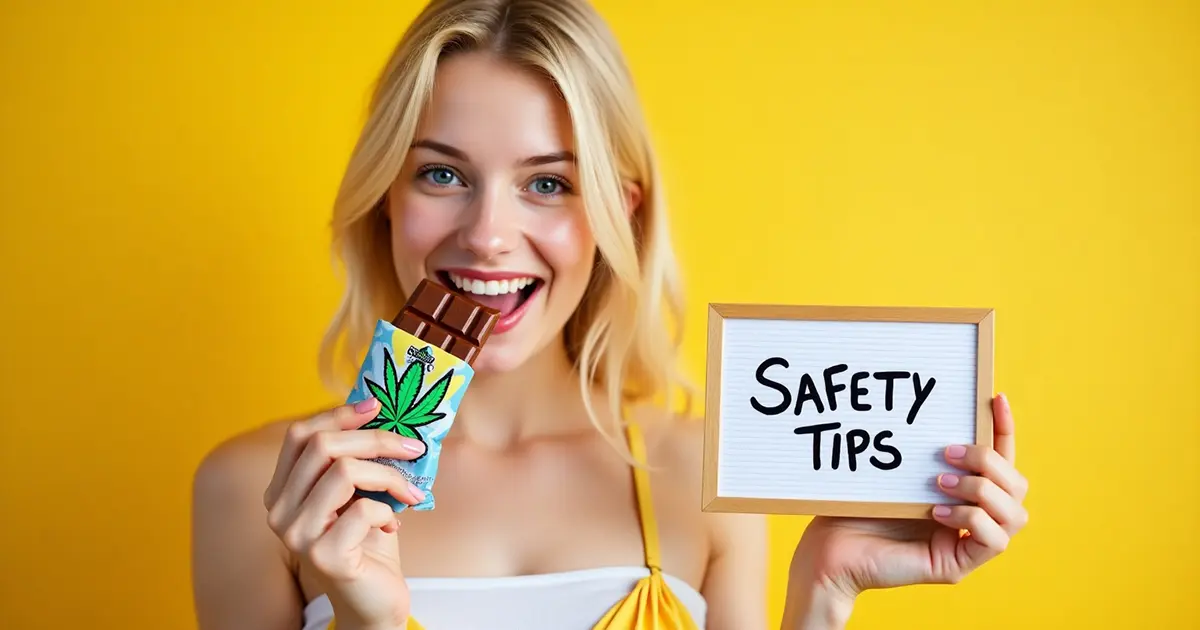How Do Edibles Work? The Science Behind THC Absorption

Cannabis Edibles are one of the most popular ways to enjoy cannabis — discreet, long-lasting, and easy to dose when done right. But how do edibles work, exactly? Why do they feel different from smoking, how long do edibles stay in your system, and what are the common edibles side effects you should watch for? This post breaks down the science of THC absorption, compares edibles vs smoking, and gives practical, safety-first guidance so you can enjoy edibles responsibly. Read on — and when you’re ready to shop, visit Get Bud Online for a curated selection of gummies, chocolates, and tinctures.
What Are Edibles?
“Edibles” is a catch-all term for any food or drink infused with cannabis compounds — most commonly THC (tetrahydrocannabinol) and CBD (cannabidiol). Common forms include:
- Marijuana gummies, chews, and lozenges
- Chocolate bars and baked goods
- Beverages (teas, sodas)
- Capsules and pills
- Cooking oils and butters for homemade edibles
- Sublingual tinctures (technically not digested, but often grouped with edibles)
Edibles deliver cannabinoids through the digestive system, which changes how the body processes them — and that’s why the effects of edibles often feel stronger and last longer than smoking.
How Do Edibles Work — Digestion, Metabolism, And Brain Effects
Understanding how edibles work requires a quick tour through digestion and metabolism.
- Ingestion and digestion. After you eat an edible, it travels to the stomach and small intestine. THC and other cannabinoids are fat-soluble, so they’re absorbed best when dissolved in a fat or oil (most quality edibles use an oil or butter infusion).
- First-pass metabolism in the liver. Unlike inhalation, edible THC undergoes “first-pass metabolism.” This means compounds absorbed from the gut are carried to the liver before reaching systemic circulation. In the liver, THC is converted into several metabolites — most notably 11-hydroxy-THC (11-OH-THC).
- 11-OH-THC — the difference maker. 11-hydroxy-THC is more potent and crosses the blood-brain barrier more readily than THC itself. This is a major reason edibles can feel stronger and more intoxicating than the same milligram dose inhaled.
- Systemic circulation and brain action. After liver metabolism, THC and its metabolites circulate in the blood and bind to cannabinoid receptors (CB1 and CB2) in the brain and body. Activation of CB1 receptors causes the classic psychoactive effects (euphoria, altered perception, slowed reaction time), while CB2 receptors mediate some immune and inflammatory effects.
- Slow onset, long duration. Because digestion and liver metabolism take time, the onset of edibles is delayed (typically 30 minutes to 2 hours), peak effects occur around 2–4 hours, and the total experience can last 6–12 hours or longer depending on dose and metabolism.

Factors That Affect Thc Absorption From Edibles
Not everyone experiences edibles the same way. Here are the key variables that influence absorption and effects:
- Dose and THC concentration. Obvious but important — more THC = stronger effects. However, because of liver metabolism, dose-effect relationships with edibles can be less linear than with smoking.
- Formulation (oil vs. baked good). Edibles made with well-emulsified cannabis oil or nanoemulsion technologies can absorb faster and more consistently than simply mixing cannabis into dough.
- Presence of fat and food in stomach. Eating edibles with a fatty meal can increase THC absorption because cannabinoids dissolve in fat. Conversely, an empty stomach may produce faster onset but can be less predictable.
- Individual metabolism and liver enzymes. Genetic differences in liver enzymes (CYP450 family) change how quickly THC converts to 11-OH-THC and other metabolites.
- Body composition and tolerance. THC is lipophilic (stored in fat), so body fat percentage and chronic cannabis use (tolerance) affect both intensity and duration of effects.
- Other cannabinoids and terpenes. CBD and other cannabinoids can modulate THC’s effects. Some formulations balance THC with CBD to reduce anxiety or paranoia in sensitive users.
The Effects Of Edibles: What To Expect
The effects of edibles are shaped by metabolism and dose. Common experiences include:
- Onset: 30 minutes to 2 hours (occasionally longer).
- Peak: 2 to 4 hours after ingestion.
- Duration: 6–12 hours typical; residual effects (fatigue, hazy feeling) can continue into the next day, especially with high doses.
- Sensation: A fuller, body-oriented high is common — deep relaxation, stronger sensations, and sometimes more intense psychoactive effects due to 11-OH-THC.
- Therapeutic effects: Pain relief, appetite stimulation, improved sleep, reduced nausea — many users prefer edibles for consistent, long-lasting symptom control.
- Cognitive impacts: Impaired memory, slowed reaction time, altered attention — avoid driving or operating heavy machinery while under the influence.
Because effects are delayed and can be potent, the most frequent user error is redosing too quickly — leading to unexpectedly intense outcomes.
How Long Does Edibles Stay In Your System?
People often ask, how long does edibles stay in your system — and the answer depends on what you mean by “stay” (intoxication vs. detectability).
Intoxication Window
- Active impairment: Usually lasts 6–12 hours after a typical dose. High doses can extend noticeable effects into the next day.
Detectability (Drug Tests)
- Urine tests (THC metabolites):
- Single/occasional users: ~1–3 days.
- Moderate users: ~7–14 days.
- Chronic/heavy users: 30 days or longer (some heavy users test positive after 60–90 days).
- Single/occasional users: ~1–3 days.
- Blood tests: THC itself is detectable for a shorter window — hours to a couple of days in frequent users. Blood tests are used to detect recent use, not long-term exposure.
- Saliva (oral fluid): Typically detects recent use — 1–3 days depending on usage pattern.
- Hair tests: Can detect THC metabolites for up to 90 days; less useful for detecting recent use but useful for longer windows.
These windows are broad estimates. Factors like body fat, frequency of use, dose, metabolism, and the sensitivity of the test all matter. Importantly, a positive test for THC metabolites does not necessarily mean the person is currently impaired.
Edibles Vs Smoking — Key Differences
Understanding edibles vs smoking helps you choose the right product and dose.
- Onset: Smoking/vaping — immediate (minutes). Edibles — delayed (30–120+ minutes).
- Peak intensity: Smoking peaks quickly and then declines; edibles build to a peak over a few hours.
- Duration: Smoking effects often wear off in 1–3 hours; edibles commonly last 6–12 hours.
- Metabolism: Smoking delivers THC directly to the bloodstream and brain; edibles produce 11-OH-THC via the liver, changing both potency and subjective effects.
- Dose control: Smoking lets users titrate in real time (take another puff). Edibles are discrete pre-dosed units, which can be safer if used correctly — but redosing too soon is a common pitfall.
- Health considerations: Smoking involves inhaling combustion byproducts; edibles avoid lung exposure but carry overdose risk via high oral doses.
- Discretion and convenience: Edibles are smoke-free and more discreet, making them attractive for many consumers.
Neither method is inherently “better”; it depends on your goals (quick relief vs sustained symptom control), sensitivity, and risk tolerance.

Edibles Side Effects And Safety Tips
Edibles side effects can range from mild to highly uncomfortable. Common side effects include:
- Anxiety or paranoia (especially at high doses)
- Increased heart rate (tachycardia)
- Dizziness or lightheadedness
- Nausea (paradoxically rare, since edibles are used to treat nausea)
- Fatigue and drowsiness
- Impaired coordination and slowed reaction time
- Cognitive fog or short-term memory issues
Severe reactions (intense panic, extreme disorientation) are unpleasant but rarely life-threatening. Hospital visits sometimes occur when people mistakenly consume far too much THC.
Harm-reduction Tips (Practical)
- Start low, go slow. For most adults: start with 2.5–5 mg THC (microdose). A standard recreational dose is often 10 mg THC. If you’re new, stick under 5–10 mg.
- Wait before redosing. Because onset is delayed, wait at least 2 hours (and preferably 3) before taking more. Some effects can keep increasing for several hours.
- Know your product. Read labels for THC content per serving and per package. If a gummy contains 10 mg and the package has 10 pieces, the whole pack is 100 mg. Don’t eat the whole pack.
- Avoid mixing substances. Alcohol and other drugs can amplify THC effects and increase risk of unpleasant consequences.
- Have a safe environment. Use edibles at home or in a comfortable place, not before driving or operating machinery.
- Store securely. Keep edibles away from kids and pets (often colorful gummies resemble candy).
- Consider CBD balance. Products with balanced THC:CBD ratios may reduce anxiety for sensitive users.
- Seek help if needed. If someone is extremely distressed, find a calm, quiet place, offer water, and seek medical attention if symptoms escalate (e.g., severe chest pain, seizures).
Practical Dosing Guide
A simple dosing framework:
- Microdose: 1–2.5 mg THC — subtle, useful for anxiety-sensitive users and daytime functional use.
- Low dose: 2.5–5 mg THC — a gentle effect for beginners.
- Standard dose: 10 mg THC — common recreational dose for many adults.
- High dose: 20–50+ mg THC — for experienced users; may cause pronounced intoxication and long recovery time.
If you’re new: choose a product with clear labeling, start at 2.5–5 mg, and wait 3 hours before considering another small amount.
Frequently Asked Questions (FAQ)
Q: How fast do edibles work?
A: Onset is typically 30 minutes to 2 hours; full effects often peak at 2–4 hours. Wait 2–3 hours before redosing.
Q: Why do edibles feel stronger than smoking?
A: Because the liver converts THC to 11-hydroxy-THC, a metabolite that crosses into the brain more efficiently and can be more potent.
Q: How long does edibles stay in your system for drug tests?
A: Detectability varies. Urine tests: days to a month+ depending on frequency; blood tests: hours to a couple of days; hair tests: up to 90 days.
Q: Are edibles safer than smoking?
A: “Safer” depends on what you measure. Edibles avoid lung exposure but have a higher risk of overconsumption if used improperly. Both methods carry impairment-related risks.
Q: Can I sober up faster if I ate too much?
A: Time is the primary remedy. Stay hydrated, rest, and remind the person that the effects will pass. Avoid alcohol or other drugs. If severe symptoms occur, seek medical help.
Conclusion — Enjoy Edibles Responsibly
Edibles offer a discreet, long-lasting way to enjoy cannabis with unique pharmacology — especially the liver conversion to 11-hydroxy-THC that makes the experience different from smoking. Knowing how edibles work, what affects absorption, how long edibles stay in your system, and the main edibles side effects helps you choose the right product and dose for your needs.
If you’re ready to try edibles or restock your favorites, GetBudOnline.com curates high-quality, lab-tested gummies, chocolates, and tinctures with clear THC labeling and dosing guidance — perfect for beginners and experienced consumers alike. Shop confidently, start low, wait long, and enjoy safely.
This post is informational and not medical advice. If you have health conditions, are pregnant, or take prescription medications, consult a healthcare professional before using cannabis.
REFERENCES:
Wikipedia. (2025, 13 May). Cannabis edible. Available at: https://en.wikipedia.org/wiki/Cannabis_edible
Jon J. Medically reviewed by Eloise T., RN, MSN, AGPCNP-BC. (2024, February 5). How long does an edible last?. Available at: https://www.medicalnewstoday.com/articles/how-long-do-edibles-last


